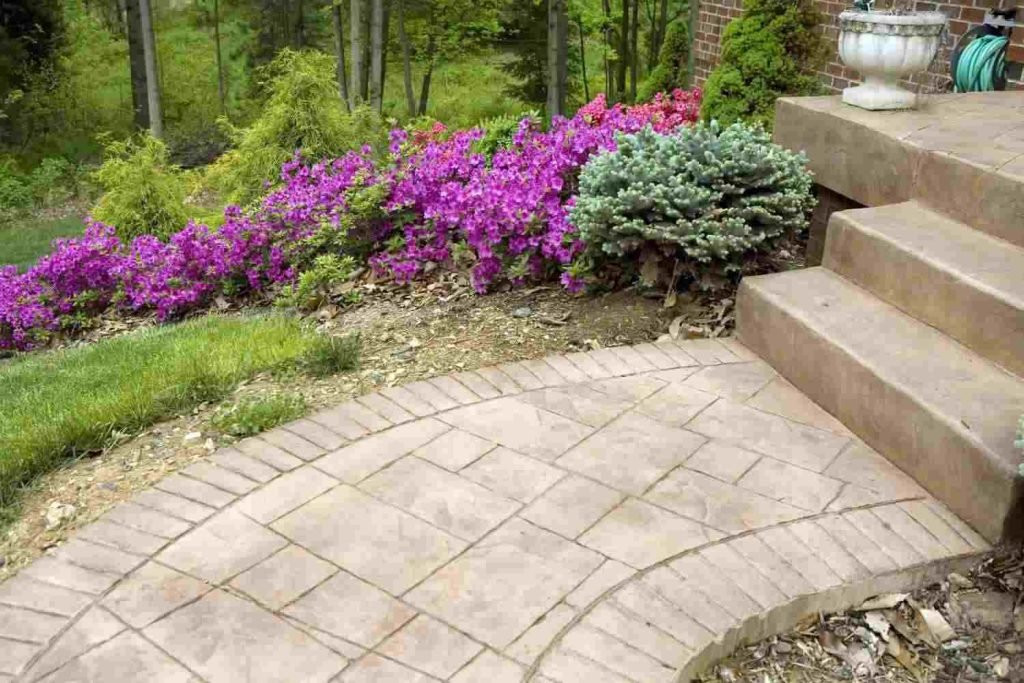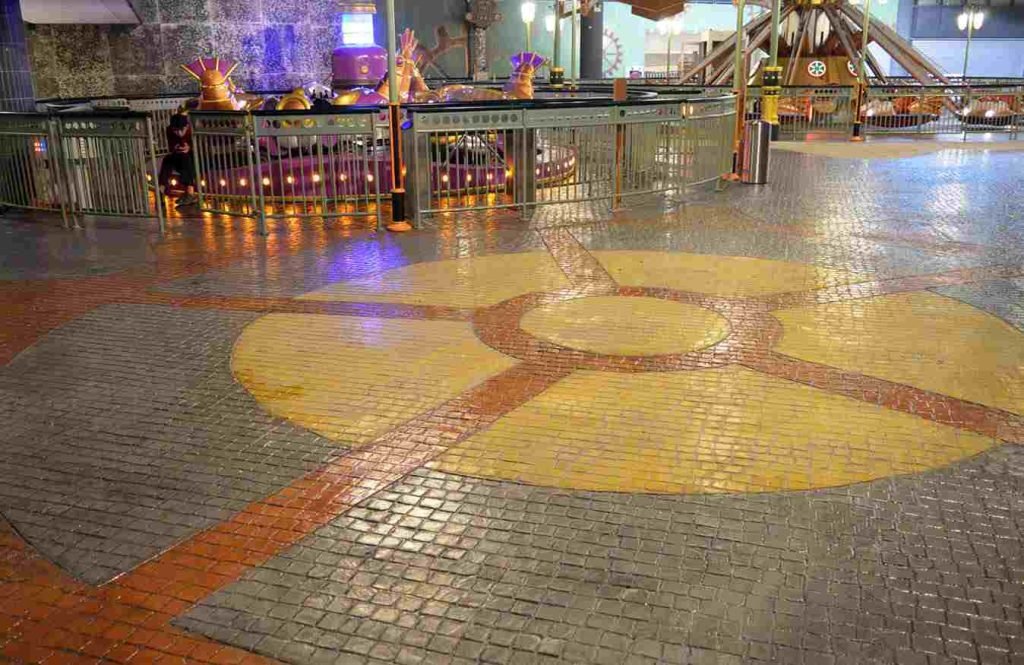Stamped concrete offers a versatile and visually appealing option for outdoor surfaces, blending the durability of concrete with the aesthetic appeal of various patterns and colors. However, the longevity of stamped concrete color depends on several critical factors that property owners must consider. From the quality of materials used during installation to ongoing maintenance practices and environmental influences, each aspect plays a crucial role in preserving the vibrant appearance of stamped concrete over time. In this comprehensive guide, BlackRock Landscape & Construction helps to explore twelve key factors that influence the lifespan of stamped concrete color, providing insights and recommendations to help property owners maximize the durability and beauty of their stamped concrete surfaces.
Quality of Materials:
High-quality materials are essential for ensuring the long-lasting color of stamped concrete. The pigments used to color concrete should be of good quality, preferably UV-resistant, to withstand exposure to sunlight without fading quickly. Cheaper pigments may save costs initially but can lead to color deterioration over time, requiring more frequent maintenance and repairs.
Similarly, the sealers applied to stamped concrete play a crucial role in protecting the color. A high-quality sealer creates a barrier that shields the concrete surface from UV rays, water damage, and stains. It also enhances the color’s depth and vibrancy, giving the concrete a more polished and attractive appearance. Investing in premium-grade color additives and sealers during the installation process can significantly extend the lifespan of stamped concrete color.
Installation:
The proper installation of stamped concrete is fundamental to the longevity of its color. Skilled contractors follow industry best practices to ensure that color additives are mixed uniformly throughout the concrete mix. This uniform distribution of color pigments helps achieve consistent coloration across the entire stamped surface, preventing patchy or uneven coloring.
Furthermore, adequate curing of stamped concrete is crucial for color retention. Proper curing techniques, such as keeping the concrete moist and protected from rapid drying, allow the color to fully develop and bond with the cementitious matrix. Rushing the curing process or exposing the concrete to extreme temperatures during curing can compromise the color’s durability.
Sealing:
Applying a high-quality sealer to stamped concrete is essential for protecting its color and enhancing its longevity. Sealers act as a protective barrier that shields the concrete surface from external elements such as UV radiation, moisture, chemicals, and abrasion. They also help prevent color fading, efflorescence (white salt deposits), and surface deterioration.
Regularly sealing stamped concrete is recommended, especially in high-traffic areas or outdoor environments exposed to harsh weather conditions. A professional-grade sealer should be used, preferably one that is specifically formulated for colored concrete. Applying multiple coats of sealer and resealing periodically according to manufacturer guidelines can significantly extend the lifespan of stamped concrete color.

Maintenance:
Proper maintenance practices are key to preserving the color and appearance of stamped concrete over time. Routine cleaning is essential to remove dirt, debris, and stains that can dull the color and mar the surface. Sweeping or using a leaf blower to remove debris regularly prevents abrasion and wear that can erode the color layer.
For more thorough cleaning, mild detergents and water can be used to scrub the surface gently. Avoid using harsh chemicals or abrasive cleaners, as they can damage the sealer and compromise the color integrity. Pressure washing with low-pressure settings can be effective for removing tough stains but should be done cautiously to avoid surface damage.
Reapplying sealer as needed is also part of ongoing maintenance. Signs that indicate the need for resealing include fading color, reduced water repellency, and increased porosity of the concrete surface. Following a regular maintenance schedule and addressing any issues promptly can help prolong the lifespan of stamped concrete color.
Usage:
The level of usage and exposure to environmental factors can impact the longevity of stamped concrete color. High-traffic areas, such as driveways or pathways, may experience more wear and tear, leading to faster color deterioration. Vehicles, foot traffic, and heavy objects can cause abrasion and surface damage over time, affecting the appearance of the stamped concrete.
Additionally, exposure to harsh chemicals like de-icing salts or automotive fluids can stain and discolor stamped concrete. Taking preventive measures, such as using protective mats or coatings in areas prone to chemical exposure, can help mitigate these effects and preserve the color’s vibrancy.
Climate:
The climate and environmental conditions in which stamped concrete is installed can influence its color longevity. Intense sunlight, frequent rainfall, fluctuating temperatures, and humidity levels can all impact the concrete’s appearance over time. UV radiation from the sun is particularly damaging, as it can cause color fading and degradation of the sealer.
In regions with extreme weather conditions, such as hot summers or freezing winters, special care may be needed to protect stamped concrete color. Using climate-appropriate sealers and implementing maintenance practices tailored to the local climate can help mitigate potential color-related issues.
Overall, a combination of quality materials, proper installation techniques, regular maintenance, and environmental considerations are crucial for maximizing the lifespan of stamped concrete color. By addressing each of these factors effectively, property owners can enjoy vibrant and long-lasting stamped concrete surfaces for many years.
Design and Pattern Selection:

The design and pattern chosen for stamped concrete can impact its color retention. Intricate patterns with deep grooves or sharp edges may be more prone to color wear in high-traffic areas compared to simpler designs. Additionally, patterns that incorporate multiple colors or shading techniques may require special care to maintain color consistency.
When selecting a design and pattern for stamped concrete, consider factors such as the intended use of the area, traffic flow, and aesthetic preferences. Choosing a design that complements the overall landscape and architectural style can enhance the visual appeal of stamped concrete while also minimizing color maintenance requirements.
Surface Preparation:
Proper surface preparation is essential for ensuring the adhesion and durability of stamped concrete color. The surface should be clean, dry, and free of any contaminants such as dirt, oil, or grease before applying color additives and sealers. Inadequate surface preparation can lead to color adhesion issues, uneven color distribution, and premature color wear.
Surface imperfections, such as cracks, spalling, or uneven textures, should be addressed before coloring to ensure a smooth and uniform appearance. Repairing minor defects and applying a suitable primer or bonding agent can improve color adhesion and prolong the lifespan of stamped concrete color.
Traffic and Usage Patterns:
Understanding the traffic and usage patterns of the stamped concrete area is crucial for assessing color maintenance needs. Areas that experience heavy foot traffic, vehicle traffic, or frequent use may require more frequent cleaning, resealing, and color touch-ups to maintain their appearance. Analyzing traffic flow and usage patterns can help identify areas that are prone to color wear and prioritize maintenance efforts accordingly.
Implementing strategies such as traffic management, protective coatings, and designated walkways or pathways can help minimize color damage in high-traffic areas. Educating users about proper maintenance practices, such as avoiding sharp objects or abrasive materials on the surface, can also contribute to color longevity.
Water Drainage and Moisture Control:
Proper water drainage and moisture control are essential for preserving the color and integrity of stamped concrete. Poor drainage can lead to water pooling, which can cause efflorescence (white salt deposits) or water-related damage that affects color appearance. Additionally, moisture trapped beneath the surface can compromise the adhesion of color additives and sealers.
Ensuring adequate slope and drainage away from stamped concrete surfaces helps prevent water accumulation and promotes drying after rainfall or irrigation. Installing drainage systems, such as French drains or surface channels, can further improve water management and protect stamped concrete color from moisture-related issues.
Environmental Pollution:
Environmental pollution, including airborne pollutants, chemical residues, and debris, can affect the color and cleanliness of stamped concrete surfaces. Pollutants such as vehicle exhaust, industrial emissions, and airborne particles can settle on the surface over time, leading to discoloration or staining. Areas near industrial sites, highways, or heavily trafficked roads may be more susceptible to pollution-related color damage.
Regular cleaning and maintenance are essential for removing pollutants and preserving the color integrity of stamped concrete. Using eco-friendly cleaning products, implementing air filtration measures, and monitoring environmental factors can help mitigate the impact of pollution on stamped concrete color.
Professional Maintenance and Inspection:
Engaging professional maintenance services and periodic inspections can help ensure the long-term durability and color retention of stamped concrete. Professional contractors have the expertise, tools, and resources to perform thorough inspections, identify potential issues, and recommend appropriate maintenance solutions.
Scheduled maintenance plans, tailored to the specific needs of stamped concrete surfaces, can include tasks such as cleaning, resealing, color touch-ups, and structural assessments. Proactive maintenance not only extends the lifespan of stamped concrete color but also helps detect and address underlying issues before they escalate into larger problems.
By considering these additional factors, property owners can take proactive steps to enhance the longevity and appearance of stamped concrete color. Incorporating design considerations, surface preparation techniques, traffic management strategies, water drainage measures, pollution control methods, and professional maintenance practices can stamped concrete surfaces for years to come.
Conclusion:
The longevity of stamped concrete color depends on several factors such as the quality of materials, installation techniques, sealing frequency, maintenance practices, usage patterns, and climate conditions. With proper care and maintenance, stamped concrete color can last for many years, maintaining its vibrant appearance and durability. Quality materials and professional installation contribute significantly to color retention. Regular sealing helps protect the color from fading due to UV exposure and enhances its resistance to stains and wear. Consistent maintenance, including cleaning and occasional resealing, can prolong the lifespan of stamped concrete color. However, heavy usage, harsh weather conditions, and neglect of maintenance can accelerate color fading and deterioration.
